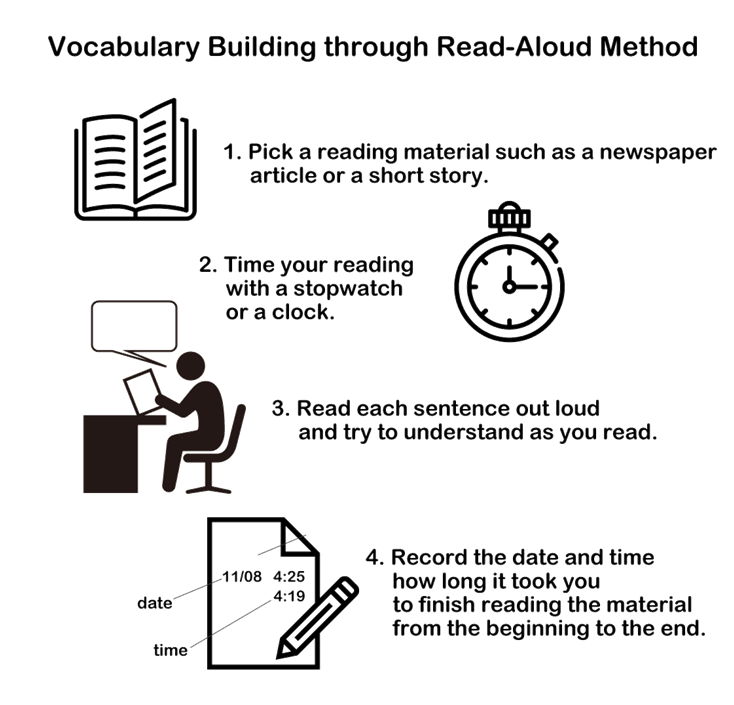A simple way to build vocabulary in a foreign language through the Read-Aloud Method
What can you do to build your vocabulary in your target foreign language? I would like to introduce one of my methods to build vocabulary effectively.

Some people use word books, flash cards, and smartphone applications to build vocabulary. I have tried such methods during junior high school days.
However, I concluded that those methods were inefficient, and I have stopped using them. I am always interested in how words and expressions that I try to remember are used in a specific context. If I remember words and expressions without context, I will not be able to use the words and expressions with confidence in communicating with others (not only speaking but also writing). That’s why I do not like to remember words and expressions without context.
For example, I heard the word “to boost” for the first time in my workplace. My coworker said that we needed strategies to boost our app downloads. Since I worked for a company that provided apps for consumers at that time, it was not difficult for me to imagine that to boost something means “to increase” or “to improve” something.

After that, I began to wonder if I could use this expression with language skills and memorization techniques. After checking several articles related to language skills, I found many writers used “to boost” with language skills or memorizing. Since then I have been using the expression in actual conversation including in my Japanese lessons. For instance, “You can boost your Japanese communications skills with this method!”
Memorizing Words and Expressions in Context
I always try to remember new words and expressions by reading short articles and stories. This helps me remember not only new words and expressions but also how to make sure they are used in a specific context and fit together with other words and expressions.
As a result of this method, you can confidently use words and expressions you acquired without hesitation in real situations. This is a very important point, especially when speaking a foreign language. If you try to figure out whether words and expressions are suitable or not while speaking, it will be difficult for you to continue a conversation smoothly.

There are multiple advantages to remembering new words and expressions through articles and stories. Unlike computers, human beings are not good at memorizing things just through mechanical input without any ingenuity. On the other hand, we are good at memorizing information linked to a specific context. Context shapes the meaning in all communication. Content is a narrative. Most of our ways of understanding the world are narratives of one form or another. They help us remember new words and expressions we’re trying to learn. Because understanding and memory are intertwined we shouldn’t be surprised that they are also very powerful mnemonic devices.
Learning method
My learning method is not complicated at all. You just need to read out loud (not silently!) articles or short stories that contain the words and expressions you want to acquire while thinking of the meaning of the words, sentences, and paragraphs.
When reading out loud, we form auditory links in our memory pathways. We remember ourselves saying it out loud, and so we not only form visuals, but we also form auditory links. Reading out loud causes us to remember better.
Time your reading and record the date and time
Time your reading with a stopwatch or a clock. Read each sentence out loud while trying to understand it. Record the date you read the text, and time how long it took you to finish reading the material from beginning to end. When you start working on new content, you will notice that the time required to finish reading gets shorter and shorter each time you read it aloud. It means you have become faster at reading. Reading aloud over time will speed up your brain’s ability to recognize and understand expressions, sentences, and the whole content. With this method, you can see the growth quantitatively and objectively. This will give you motivation to keep up your studies.
Though it might feel tedious to do this over and over, timing your reading makes you notice even small changes in your growth. For example, you may feel that you are able to read some content very quickly.
The reason why I always record the date is so that I can see how long ago I read that piece. For example, when I pick a piece to read, and I can see the date I last read it, I might think, “Oh, I haven’t read this content in a few months. Let’s refresh my memory which I might have lost…” The date tells you the timing when you need to refresh the memory.
How to pick content (articles or stories)
Regarding content, I consider it best to choose pieces that you can finish reading within 5 minutes or less. In my case, I find it a bit difficult to concentrate over 8 minutes. However, what should we do with long content that takes more than 5 minutes to read? If you finish reading the content within 7 minutes on the first round, you could shorten the time within 5 minutes after reading it out loud several times. On the other hand, if it took more than 8 minutes, it seems difficult to shorten it within 5 minutes. In that case, please divide the text into two, the first half and the second half. For example, there are long articles that take about more than 20 minutes to finish reading in total; I divide them into four parts.
Increasing the number of pieces to read aloud
When you read one piece 15 times or more, you will be able to understand not only its surface meaning but also its themes and deeper meanings as well as visualize it more specifically. Of course, I’m sure that you will remember the words and expressions used in it during the entire reading process. Once you feel you fully understood the piece and remembered the words and expressions, it is time for you to add new content to increase your vocabulary.

After reading aloud the new content many times, please go back to previous content and read that aloud again to refresh your memory of words and expressions that you might have forgotten. If you repeat this process, you can keep words and expressions in a fresh state, and they become committed to long-term memory. As a result, you will be able to use them whenever you need them.
I hope this is useful for you.
Related link
The link between memory and stories




